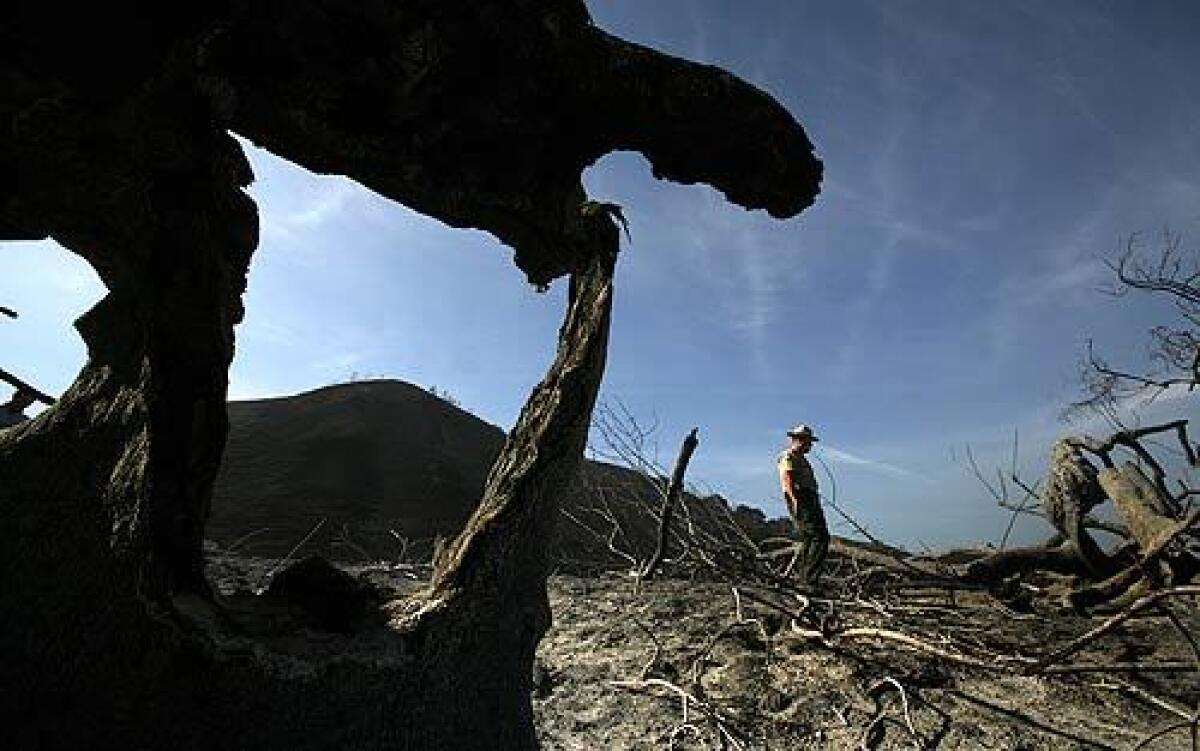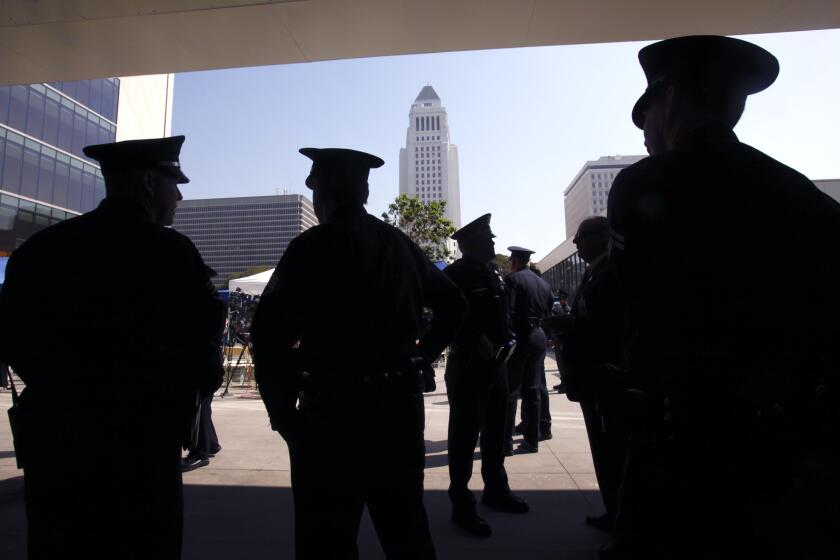Disbelief over a charred Chino Hills State Park

For more than 20 years, Chino Hills State Park has stood as an island of wilderness circled by freeways and untrammeled development. Swaying grasslands and remote canyons offered solitude to hikers and bikers. Rare plants and wildlife flourished.
That all changed recently when a tidal wave of wind and fire swept through, with flames shooting 80 feet into the sky. More than 95% of the park’s 14,100 acres -- including old oaks, stately sycamores, bridges, rabbits and grasslands -- were incinerated, leaving little but ash behind.
The breadth of destruction has left many numb.
“I don’t know if I even want to go in yet because the emotional impact would be too great,” said Claire Schlotterbeck, executive director of Hills for Everyone, a nonprofit dedicated to protecting the Puente-Chino Hills natural environment that helped create the park in 1984.
“It is just devastating,” she said. “There has never been a fire in these hills that consumed all these acres in one fell swoop. It’s just a moonscape.”
The park will remain closed until it can be cleared of debris.
The 31-mile-long tableau of undulating hills and canyons touches Riverside, San Bernardino and Orange counties and is within a half-hour’s drive of 15 million people. It is part of an important wildlife corridor that connects to the Santa Ana Mountains and is home to bobcats, mountain lions, reptiles and 200 species of birds, including the threatened least Bell’s vireo.
Park Superintendent John Rowe watched the park tragedy unfold shortly after the Freeway Complex fire began in Corona on Nov. 15.
“It took about 20 minutes to get from the point of origin to the park,” he said, as his truck bounced up Scully Ridge recently with nothing but black scars of ash on either side. “Once it passed Green River, I knew we couldn’t save the park and the focus would be on structure protection.”
He hopped out with binoculars to scan the hills for signs of life. Red-tailed hawks and turkey vultures wheeled tightly overhead. A rabbit dashed for cover in a blackened thicket. There were few places left to hide. Scavengers found easy pickings among the animal carcasses littering the park.
Rowe walked across a landscape reduced to broad sheets of charcoal, past skeletal remains of sycamore trees near Aliso Creek.
Some, he said, will be left as wildlife habitat. Others are being evaluated by park service foresters, who will decide if they should be removed. Small pockets of trees, including the rare black walnut, escaped the fire along with some coastal sage.
“You are within three of the most populous counties in the nation here, but when you are down in these canyons you can’t even tell you are in Southern California,” Rowe said, crunching along through cinders. “Stop and imagine that this fire didn’t happen. Look around you. You can’t get this anywhere else.”
A yearning for nature and isolation may account for why so many homes have sprung up around the park in recent years, closing in on it from nearly every side.
“I look at this as the cumulative effect of really bad land-use decisions. The park was there and cities and counties built right up to the edge of it, leaving no buffer,” Schlotterbeck said. “The park has never started a fire, but the consequences of these land-use decisions were borne by the park, the wildlife and the taxpayers.”
She said a housing project in Brea, with 165 homes, is planned for a ridge overlooking the park.
“How ludicrous is it to put people in harm’s way like that?” she asked.
Fire isn’t new to the park. One burned 3,000 acres five years ago, and smaller ones have erupted from time to time. Though wildfires are part of life in Southern California, they can cause permanent damage, scientists say.
“Within Chino Hills State Park, and regionally, we are having fires burn at shorter intervals than would occur naturally, and these habitats cannot recover from repeated fires,” said Ken Kietzer, environmental scientist for the Inland Empire district of California State Parks. “Portions of the park have burned about five years apart over the last 15 to 20 years. They can’t recover quickly enough.”
The result, often, is an invasion of non-native plants. Grasslands replace forests because trees don’t have time to regrow.
The park should burn about every 20 years, not every five, scientists say.
Still, as denuded as it appears, that the park will recover is a near certainty. Winter rains will allow seeds to sprout, reforestation will occur and volunteers are already lining up to help rebuild trails. Erosion and mudslides are serious threats, as are invasive plants, but other parks that have faced similar situations have found ways to deal with them.
Griffith Park, in a densely populated area of Los Angeles, was hit by fire in May 2007.
“We lost more than a quarter of our 4,000 acres,” said Jane Kolb, spokeswoman for the city of Los Angeles’ Recreation and Parks Department. “The hills were bare and the trees were gone.”
Helicopters dropped specialized mulch to firm up hillsides and prevent erosion. An army of volunteers worked Saturdays helping to reseed and replant burned areas. The Sierra Club joined in, as did the California Department of Forestry and Fire Protection and other agencies. The city spent about $2.5 million on the effort, Kolb said.
“We had to close many of the hiking and horse trails, but many have reopened,” she said. “You can still see where they burned.”
Santiago Canyon in Orange County burned last year but also has seen substantial recovery.
At Chino Hills State Park, damage assessments are underway and foresters are scheduled to start clearing dead trees Dec. 8.
Despite the damage, plenty of surviving wildlife has been spotted.
“I actually saw a deer, a coyote, a handful of bird species, a golden eagle, a California kingsnake and fresh bobcat tracks,” Kietzer said. “It’s a big disaster, but there is reason to be optimistic the wildlife is adjusting to the fire.” Still, he added, “Some will move out until the park comes back.”
In nearby Chino Hills, a few residents recently gathered outside a locked park gate to examine the burned hillsides.
“I find the park excruciatingly beautiful,” Sally Mollett said. “It’s as green as can be, and you can see life as it was in there.”
She turned to Rowe, the park superintendent.
“Did the giant oak and sycamore down by the river survive?” she asked.
He nodded.
Mollett’s 11-year-old son, James, and his classmate Jacob Hurd seemed concerned. The boys said they hope to do a 5th-grade science fair project on the park’s restoration.
“It’s just so horrible to think of all the animals in there that died or have no homes,” James said. “I feel very sorry for them. Animals have feelings too.”
Kelly is a Times staff writer.
More to Read
Sign up for Essential California
The most important California stories and recommendations in your inbox every morning.
You may occasionally receive promotional content from the Los Angeles Times.










